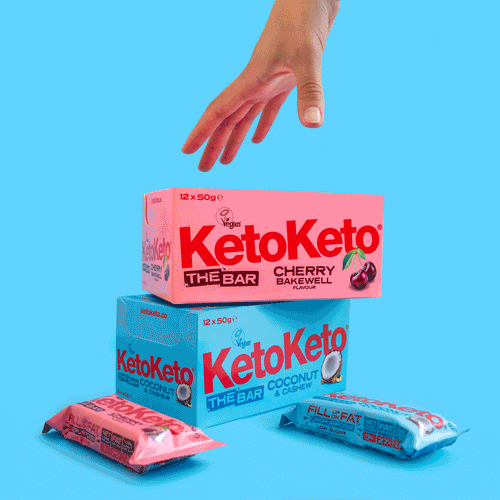There’s a lot of new jargon to familiarise yourself with when you first learn about healthy eating - one of them being macros. What are they and why does everyone keep talking about them? How are you supposed to work them out once you’ve figured out what they are?
It really isn’t complicated, so we’ve simplified the whats and hows of macros so you can focus more of your time on the things that bring you joy.
What Are Macros?
Macros are simply the shortened name for macronutrients. Macronutrients are the three main food groups we eat to fuel our bodies - fat, protein and carbohydrates. There’s nothing more to it! So now you can chat about macros to your heart's content, without feeling like you missed the memo.
The difference with Keto is the proportion of macros compared to other popular eating styles. The Ketogenic diet is mostly fat, a moderate amount of protein, and very little carbohydrates. Whereas the typical modern diet is mostly carbohydrates, some protein and minimal fat.
Fats
Keto is focused on the fats you consume. They’re the main part of a Ketogenic diet because the purpose of Keto is to fuel your body by burning fat, rather than glucose. The percentage of fat you should be consuming on a Ketogenic diet is 80%.
Fat is good for your health, despite what many health advisors have suggested in recent years. It’s the quality of the fat that matters. When you include healthy fats in your diet such as medium-chain triglycerides and Omega-3 fatty acids, you support your body with essential nutrients for nerve, muscle and immune health. Good levels of healthy fats can also improve blood cholesterol levels and reduce inflammation.
It’s little known that fats are also vital for the absorption of other important nutrients such as Vitamin A, D, E and K.
Fat is great for helping you feel satiated and fuller for longer, so you don’t experience hunger spikes and cravings. Contrary to common belief, healthy fats can actually help you lose weight rather than gain it.
Protein
The advice on the percentage of protein you should include in your diet tends to be similar across different diet plans. On Keto, you ought to be aiming for between 15-20% of your calories from protein.
Proteins are made up of amino acids, which are the building blocks of all the tissues in your body. It’s therefore really important that you include a moderate amount of protein in your diet so that your tissues can grow and regenerate correctly. If you don’t get sufficient amounts of protein, you can suffer from serious health problems.
Protein-rich foods help you feel full for longer and keep hunger at bay. Some great Keto-friendly sources of protein include: meat, poultry, fish, eggs, cheese, and tofu.
Carbohydrates
Only minimal if any carbs should be included in your meals or snacks on Keto. This is a real challenge for many who’ve grown up with a carbohydrate based diet. The goal is less than 5% of your calories to be carbohydrates. In reality, this percentage is a tiny amount of your daily food intake, especially when you work out your macro allowance based on your personal needs.
What surprises many is the amount of carbohydrates found in many vegetables, fruits and pulses, let alone the obvious carbs in the bread, cakes and biscuits which are common in our modern diet. But the reason for reducing your carb intake is important - this significant switch from carbs to fats for energy can help reduce many inflammatory and autoimmune diseases, obesity and mental health problems. Dozens of studies have shown the improvement in health for those individuals who take on Keto.
Why Do I Need To Calculate Macros?
Not everyone calculates their macros, it isn’t strictly necessary and many benefit from eating Keto without ever working them out. The idea of doing maths to eat can also be daunting and off-putting. But it doesn't need to be.
Calculating macros can get you to feel the benefits and positive results faster, and improve your health exponentially. If you want to make sure you’re benefiting the most you can from eating a Keto diet, it’s a good idea to calculate your macros.
By counting your macro allowances you can truly understand where your calories should be coming from, and you can make the smartest food choices for your body. Everyone is unique, and the amount of macros you need to keep you full and healthy will be different to the next person on Keto. By understanding your personal requirements you can cater your eating plan specifically for you, and make sure you feel your absolute best and achieve optimum health.
You will probably also find that measuring the correct macros to put on your plate is a whole lot easier than working with a vague percentage.
How Do I Work Out Macros?
Here’s the fun part - working out your personal macros! While you may be hesitant about doing the calculations, it’s actually simple once you know how. Failing that, there are many online tools and apps that work them out for you, simply search for ‘macro calculator keto’ (or a variation of) and you’ll find many free options.
It’s exciting to discover how to cater for your personal eating plan and get certainty about how to portion your plate. Working out your macros will give you specific amounts of fats, proteins, and carbs to include in your meals - to the gram. To find out your macro amounts you will need to include information about your height, weight, activity level and gender
Step-By-Step Guide
1. Work Out Your Calorie Intake
To begin, work out how many calories you need each day. This will depend on your BMR (Basal Metabolic Rate) - how many calories your body needs to survive. To find out your BMR you can use this handy calculator.

2.Decide Your Macros
This is outlined for you with Keto - less than 5% carbs, 15-20% protein and 80% fat. You could decide on a specific percentage rather than a range for carbs and proteins, depending on how you would like to begin. For example, you could decide on 3% carbs and 17% protein to start. This will give you a definite quantity to work with that can help you stay on track, and rest assured knowing you're eating the right amounts. You can always adapt this as you find things easier or more difficult.

3. The Maths
Now you have your personal DAC and your macro ratios for Keto, you can go ahead and calculate the exact number of grams per macro to include in your daily diet. Both protein and carbohydrates provide 4 calories per gram, while fat provides 9 calories per gram.
Use the following equations to calculate your exact macro amounts to the gram:

Easy Ways To Keep Track of Macros
Now that you’ve figured out exactly how many macros you ought to be eating a day, you need some tools to help you keep track. There are many great apps you can download to your phone to help you keep track throughout the day. This may be especially helpful if you’re always on the go and need something you can easily update on a whim.
Another great way to keep track is to simply take note of the amount of macros you eat at each meal or snack. This can again be done on your phone or you could use a good old notebook and pen.
Either way, as long as you keep track of what you’re eating throughout the day, you can keep on top of the macro quantities you’ve consumed.

KetoKeto Bars
Save big when you bundle up with KetoKeto. Low in net carbs and developed to have minimal impact on blood sugar levels, over 10,000 people in the UK trust us for their keto snacks.
Tailor Keto To You
Hopefully you’ve learned exactly what macros are and precisely how to work them out for yourself (if you enjoy some arithmetic). Perhaps you just want to know what your macros ought to be and would rather use an online calculator - no problem, there are plenty of free macro-Keto-calculators available online.
Whichever way you choose, working out your macro quantities to the gram is especially helpful on Keto. It will help you reach your goals faster, keep you in Ketosis, and ensure you’re eating the right amounts for your body and lifestyle.
Keto isn’t a one-size-fits all, and an athletic petite woman will need a completely different quantity of macros compared to a more sedentary male. Calculating your macros will help you discover the amount of calories your body needs and tailor your Keto plan to you.
Armed with this macro info, you can quickly and simply enjoy the benefits that come from looking after yourself on Keto.






